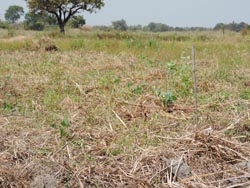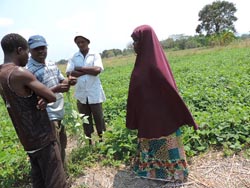Kilombero Valley, located in south-central Tanzania, is a major rice production area with smallholder rice schemes occupying about 2,080 square kilometers. Rice production is largely based on rain-fed lowland cropping systems, where rice is grown over the wet season, and field left fallow over the dry season. Demographic growth and increased demand for land are forcing many farmers to intensify their rice production systems. Declining fallow length and increasing number of crops before leaving the land to extended fallow significantly reduce yield. Promising cropping system options include rotation of rice with grain legumes. However, poor knowledge of legume technology among farmers and the near complete absence of research on fallow management in this extremely diverse lowland rice-based systems require a multiscale approach for generating and extrapolating fallow technology. N2Africa and AfricaRice aim to develop a system based on rice production in the wet season, followed by cowpea that will utilize the residual moisture in the dry season. The aim is to sustain productivity gains and provide farmer with income over a greater portion of the year.
|
A poorly established and growing cowpea crop at Mkula ward. The crop was planted late on a heavy clay soil. The top soil layer dries up faster limiting proper weeding. |
A well performing demonstration on cowpea GAPs at Idete wardin Kilombero district. The crop was planted after harvesting rice to utilize the residual moisture. A farmer (a woman in the picture) applied rice straw as mulch to conserve the soil moisture. |
In June, 2014, just after harvesting rice, twelve demonstration trials were established in Mkula, Kisawasawa and Idete wards to test the Good Agricultural Practices (GAPs) for cowpea (use of improved seed, planting on line at proper spacing of 60 cm x 20 cm, timely weeding and use of insecticides). Set up of the demonstration adopted the N2Africa approach of development to research and adaptation. The Results so far indicate that crop establishment and growth varies with site and management. Poor crop establishment and growth are observed on heavy soils, compounded by poor crop management (late planting and inadequate weeding). Inherent low soil fertility and poor soil structures as a result of wet cultivation for preceding rice also limit crop establishment and growth. Management of soil moistures is also key in this rice-grain legume rotation system. Agronomic and management strategies need to be developed to minimize these constraints. Nevertheless, farmers are exited and show potential for adoption of cowpea and accompanying GAPs such as early planting, retention of rice straw as mulch and use of improved seed. More experiments to examine the effect of these treatments on cowpea production and the effect of cowpea on subsequent rice will be implemented in June 2015.
Freddy Baijukya


